(48)
the ever changing faithless world:
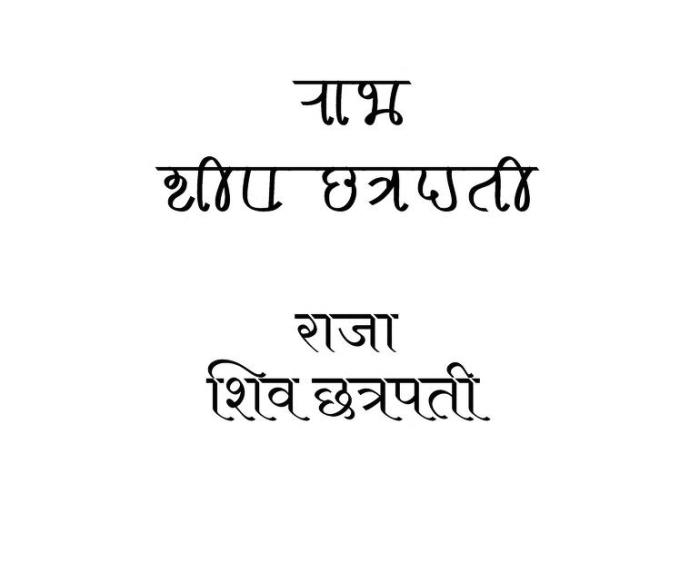

 (१) दारी गजान्त लक्ष्मी, जणुं पौर्णिमा सुखाची!
(१) दारी गजान्त लक्ष्मी, जणुं पौर्णिमा सुखाची! (२) काळ अाला ! काळ अाला ! पेटलेल्या वासनांनी ! धाड ही पडली गिधाडी ! वेढिलें दु:शासनांनी !
(२) काळ अाला ! काळ अाला ! पेटलेल्या वासनांनी ! धाड ही पडली गिधाडी ! वेढिलें दु:शासनांनी !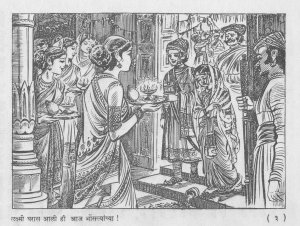 (३) लक्ष्मी घरात अाली ही अाज भोंसल्यांच्या !
(३) लक्ष्मी घरात अाली ही अाज भोंसल्यांच्या ! (४) चिरडुनि गेली, भरडुनि गेलीं, नातींगोतीं क्षणांत सारी !
(४) चिरडुनि गेली, भरडुनि गेलीं, नातींगोतीं क्षणांत सारी ! (५) दे अंबिके, दे चंडिके, दे शारदे वरदान दे !
(५) दे अंबिके, दे चंडिके, दे शारदे वरदान दे !
Life as I see it, has five essential `F’s’. Many people may not agree to them, but then this is my blog, so I will tell, whether you like it or not. I will give my reasons for each one, why it is esential according to me. You may agree, or disagree, or give no opinion, it does not matter. Since this blog is more like a personal diary, which I will not link to anybody, I think it is safe to write things here, which I would not like to be in public.
[But then am I not contradicting myself, when I am putting my personal thoughts in a public place?]
So the five F’s
Archimedes & The Law Of The Lever
The lever presents us with one of the most simple of machines that humans have invented. In fact the lever is one of the six simple machines, which are the building blocks of any complicated, mechanical equipment that we produce. The total six simple machines are:
▪ Lever
▪ Wheel and axle
▪ Pulley
▪ Inclined plane
▪ Wedge
▪ Screw
Simple machines are devices which use mechanical advantage to multiply force. Simple machines can be used to increase the output force, this is at the cost of a proportional decrease in the distance moved by the load. With the mechanical advantage that you get in a lever, you can lift large loads, with application of much less force. We use levers in a variety of ways in our daily life. Just to name a few, the weighing balance, see-saw, even when you lift a weight with your own hand! How many can you identify?
But being a simple machine does not mean that the secret of it can be derived very easily. Just given with a lever, some weights and no other knowledge it is hard for us to derive the mathematical expression for the law of lever. Whereas the Newtonian mechanics gives us a proof, we will see how this proof was presented first. The proof is by Archimedes. Archimedes was the first person to reason and build a theory about the lever, amongst many others things he did besides crying Eureka!! We will sketch the outline of his proof about the law of lever.
If two weights w, W are placed on a horizontal weightless stick, which rests on a support called the fulcrum. One of the following three scenarios will occur. Either the stick will tilt towards the right or the left side, otherwise it will remain horizontal. When the stick remains horizontal it is said to be in equilibrium position. Archimedes considered the question:
“If W is at a distance D from the fulcrum and w is at a distance d from the fulcrum, what condition on W, D, w, d corresponds to equilibrium?”

The answer known to almost all students of physics is that the products wd and WD should be equal. Archimedes did not give a proof to this law in this form. For it is said he would have been offended by multiplying two entirely different quantities such as weight and length. The balance is expressed by him in terms of equality of two proportions W : d = D : w. The statement is that the weights balance at distances inversely proportional to their magnitudes.
Archimedes made some assumptions, which were supposed to be self evident. The assumptions are:
Archimedes uses this assumptions to prove propositions which lead us to the law of the lever. The point in the proofs is that the assumptions should not contradict each other.
Proposition 1: Weights that balance at equal distances from the fulcrum are equal.
Proof: If they are not equal, remove the greater weight difference of the two weights. We have now two equal weights at equal distances from the fulcrum. But according to assumption 3 they do not balance. This contradicts assumption 1. Hence the proof.
Proposition 2: Unequal weights at equal distances do not balance, but the side holding the higher weight goes down.
Proof: Take out the difference between weights, by assumption 1, the remaining two weights balance. If we put back the weight that we have taken, then by assumption 2 weights now do not balance.
Proposition 3: Unequal weights balance at unequal distances from the fulcrum, the heavier weights being at the shorter distance.
Proof: Suppose that the heavier weight is W which is placed at A, and lighter weight w placed at B and the fulcrum is at C, consider the case that they balance each other. Remove W – w from the heavier weight W, thus we have two equal weights. Now by assumption 3, the remaining weights do not balance, but w goes down.
But this is not possible for the following reasons:
Either AC = CB, AC greater than CB, or AC less than CB. Archimedes rules out the first two possibilities. If AC = CB, by assumption 1 the remaining weights balance. If AC is greater than CB then again by assumption 1 weight at A will go down. Thus AC must be less than CB.
Proposition 4: If two equal weights have different centers of gravity, then the center of gravity of the two together is the midpoint of the line segment joining their centers of gravity.

[Archimedes does not define the term “center of gravity”, but approaches the term axiomatically. For a mathematical definition knowledge of integral calculus is required. But we can still understand the term in physical terms. We can assume that all the weight is concentrated at the center of gravity. Another ways is to visualize that the entire weight acts as if it is located at one point, which we know as centre of gravity. ]
Proof: Let the equal weights be w and W, with centers of gravity located at A and B. Let M be the midpoint of the segment AB. Assume that the weights balance at C, a point different than M.
The distance AC is not equal to the distance CB. Hence by Assumption 1 the weights do not balance each other, no matter how C is chosen, as long as it is different from M. This implies that M must be the balancing point.
Here a tacit assumption is made that any two weights have a center of gravity, that is, a balancing point. It is a restatement of Assumption 1 in terms of center of gravity.
Corollary: If an even number of equal weights have their centers of gravity situated along a straight line such that the distances between the consecutive weights are all equal. Then the centre of gravity of the entire system is located on the midpoint of the line segment joining the centers of gravity of the two weights at the middle.
The figure below illustrates the corollary. The center of gravity of the six weights is at C.
Proposition 5: Commensurable weights balance at distances from the fulcrum that are inversely proportional to the magnitudes of the weights. More precisely, if commensurable weights W and w are at distances D and d form the fulcrum, then:
D/d = (1/W)/(1/w) = w/W
[By commensurable it is meant that the ratio of w/W is rational, i.e. there is a third number m such that W = pm, and w = qm and w/W = q/p, and p and q are whole numbers.]

Proof: For convenience let us take a specific case let the ratio of the weights be known, lets say 2:5. So that w/W = 2/5. Let w and W be located at A and B. Let M be their balancing point. What is needed for the proof is that AM : BM = 5:2.
AM/BM = [1/2] / [1/5] = 5/2
We cut the segment AB in to 5 + 2 = 7 equal parts. Divide the weight W into 2*5 = 10 equal parts, and place 5 of them at the midpoints of the five sections just to the right of B, one in each section and five of them in congruent sections to the left of B. Similarly divide w, into 2*2 = 4 equal parts and place 2 of them on the left of A at the and 2 of them to the right of A.
Thus we have a collection of 10 weights each W/10, whose centre of gravity is as same as that of W i.e. B. Similarly the centre of gravity of the w/6 weights is same as that of w, i.e. A. We now have a system of 14 equal weights, which are equally spaced. This collection of 14 weights by the corollary to Proposition 4 balances around the midpoint of the segment holding the 14 weights. This implies the ratio of the lever arms is 5:2, since AM has 2 little weights, and BM has 5 of them. This completes the proof.
Proposition 6: Incommensurable weights balance at distances inversely proportional to their magnitudes.
Proof: Let the weights be W and w at respective distances D and d from the fulcrum. Assume that WD = wd and that the two weights do not balance each other. Assume that weight W goes down.
Remove a small amount of weight from W to obtain W’ such that W’ still goes down but W’ and w are commensurable. Since W’D < wd, W’ rises. This contradiction – that both W’ rises and goes down – proves the proposition.
Is that what prompted him to say
“Give me a place to stand and with a lever I will move the whole world.”
Given the things that he asks for i.e. a place to stand and a lever, will a single person be able to lift the earth?
Let us do some order of magnitude physics for this. We assume that we have a strong rigid rod which will act as lever, which is sufficiently long. Lets say that we have a strong person of who can apply a force of $10^3 N$. We know that the weight of earth is $10^{25} N$. We then calculate in order to displace the earth by 1 cm, how much distance Archimedes will have to move. So that $ \frac{10^{25} \, N}{ 10^3 N} \times 1\, cm \, = \, 10^{22} \,cm}$. Now $10^{22} \,cm \, = \, 10^{20} \, m$. This is too large a distance. So even if Archimedes moved at an fantastic rate of 100 m/s it would still take $10^{18} \, s $ to complete the arc of $10^{20} \, m$. This is equal to $ 3 \times 10^{10}$ years or 3 million years. So to do this fantastic job, Archimedes would have to be incredibly powerful, supplying $10^3 \, N$ force for such long, and also should have a fantastic age of 3 million years!!
But anyways Archimedes was a great man, no doubt about that. Archimedes is referred to as greatest mathematician, physicist and engineer of the antiquity. We will get to other wonderful discoveries of the Archimedes soon…
Mach gives albeit a somewhat different account of the derivation of this law.
References:
Archimedes: What Did He Do Besides Crying Eureka?
Sherman Stein
The Science of Mechanics
Ernst Mach
PS: Typing math without LaTeX is a pain….
PPS: Finally \ \LaTeX \ on the blog \ \ldots \
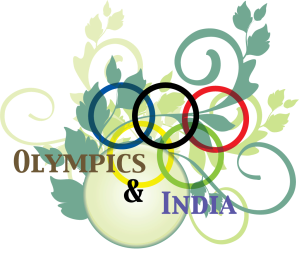
This Olympic in China in 2008 was one with a difference… Our highest Medal grosser the hockey team did not even qualify the same. Then there was a huge cry over this. Many people came out of their slumber about the decaying state of hockey in the country. Hockey being the national game [which is sic] attention should be given to it. The hockey team in its golden years was unbeaten in the Olympics for six years. Thereafter also we did not do a bad show.
The medals dried up, literally. And maybe due to the spirit of socialism, we were never good in individual games. Although we did get some medals in hockey, if not gold, the other individual medals were never there. You can literally count them on the tips of your fingers [and I am not joking]. Here are the individual medals by Indians in the Olympics in the last 108 years of history.
| Norman Pritchard | 1900 Paris | Athletics | Men’s 200 metres | |
| Norman Pritchard | 1900 Paris | Athletics | Men’s 200 metre hurdles | |
| Khashaba Dadasaheb Jadhav | 1952 Helsinki | Wrestling | Men’s freestyle bantamweight | |
| Leander Paes | 1996 Atlanta | Tennis | Men’s singles | |
| Karnam Malleswari | 2000 Sydney | Weightlifting | Women’s 69 kg | |
| Rajyavardhan Singh Rathore | 2004 Athens | Shooting | Men’s double trap |
So that before 2008 there are only 6 medals, which I guess you can count with your finger tips, so I was not joking. Mind you there were no medals, any type, between 1980 and 1996 till Leander Paes broke the jinx. What was the government doing then? I mean a nation with second largest population in the world doing so badly in the Olympics and nobody felt anything, nobody did anything? What can be the reasons for this, if not bureaucracy? The officials and the ministers who are related to the Department of Sports are not accountable for what happened. The bureaucrats were secure in their air conditioned offices for the job they would do till the end of their term, while ministers even when changed did not try to bring about change that was desperately needed. They have attained nirvana, if not this Olympics, the next one, which is just 4 years away. I guess the slogan was हम होंगे कामयाब but no body tried. But for a sportsperson it is an different scenario, in four years the world entirely changes, the same form cannot persist for four years, unless you are exceptionally talented. But given the conditions that our sports facilities are in, who will persist with their current form? I have also heard that we have more “Olympic Officials”, who are supposed to be more important than the players themseleves, in the Games. For the babus it is a state sponsored international holiday. And the people who adopt sports as a career, they say, “Do not have a future.”
I think apart from the omnipresent bureaucracy, we our society as a whole, have failed our sportspeople. The encouragement and respect that people in sports get in India is way below, what they should be getting and deserve [Exception being cricket].
Things were drastic during this Olympics. Our old work horse, the national game, Hockey team did not even qualify for the Olympics. It was too late for our Olympic Association that the world has advanced much too far away from us, and we have to speed up. The first step was to remove KPS Gil
l, the old man who controlled [literally] the Indian Hockey scenario. This step should have been taken long ago. They say Gill destroyed two things, terrorism in Punjab and hockey in the nation. Lets see what results does thus bring. I hope for the best!!
As for the 2008 Olympics, even though veterans could not perform, the youngsters showed the way. Starting from Bindra the jinx was broken. The others who just failed to register a medal, require equal appreciation. They tried their bast but, somehow did not manage it. But alas dudes I am with you…
Some of the people who could not steal the limelight, but were there are [apologies for the omissions]:
Saina Nehwal
Akhil Kumar
Jitender Kumar
Neha Agarwal
Yogeshwar Dutt
and many others whom I have failed to list… And for the hereos here they are Vijender Kumar Sushil Kumar
Abhinav Bindra
You guys will be heroes for generations to come…
But will it make a difference in the next Olympics?
I guess the best bet would be to release the spirit of The Game from Babus who do not understand The Game. Out source it, corporates should take interest in this sector and should be given the responsibility of preparing our sports people for the next games…
Adios and best of luck till next time…

Recently I got a forward email…
It read thus:
Dear Indian!
Greetings on Independence Day!!The National Flag is a symbol of the Nation’s respect and pride. There is a liberal use of the flag on Independence Day and Republic day. There is a new trend of selling flags made up of paper and plastic, which is incorrect.
Do’s and Dont’s
- Hoist the Flag at a height in a suitable manner.
- Do not let small children use the National Flag as a toy.
- Do not use or buy plastic Flags.
- Do not use paper Flags to pin up on shirt pockets, etc.
- Take care to see that the Flag does not get crumpled.
- Do not use the Flag as a banner or for decoration.
- Take care to see that the National Flag is not trampled upon or torn.
- Do not let the Flag fall on the ground.
- Do not join cloth pieces to resemble the National Flag.
What do you say? Do you agree? Of course, most of us would. But why? Why does the respecting the National Flag mean respecting the nation? I do not agree completely though…
I will elaborate what I mean to say…
For most of us Indians, The Flag represents The nation. The Flag is an iconification of our national pride. We like to have icons for everything that we respect. That channels our feelings towards the thing respected. The Flag is just like the idolization of many things, you respect the idol, you respect the thing. National Flags project the identity of a nation, they represent and foster the national spirit. The unique designs and colours the flags embody, reflect a particular nation’s character and declare the nations’s separate existence. It is the identity of The Nation. Thus it is but natural that a national flag has a great amount of significance. The respect and dignity of the flag needs to be fostered and maintained, for which explicit rules have been laid down. The rules provide against the burning, mutilation and destruction of the flag. The above mail was a sort of Flag Hoisting for Dummies which contained do’s and dont’s derived from such rules. Respect for the National Flag would mean that the you are respecting the values for which the national flag stands for. The history and the various protocols related to our National Flag refer to the Wikipedia entry, very comprehensively written.
Our flag, therefore, is both a benediction and beckoning. It contains the blessings of all those great souls who brought us to freedom. But it also beckons us to fulfil their vision of a just and united India. As we confront crucial challenges to our security, our unity and integrity, we cannot but heed to the call of this flag to rededicate ourselves to the establishment of that peaceful and just order wherein all Indians irrespective of creed, caste or sex will fulfil themselves.
R. Venkataraman“[The National Flag is] a flag of freedom not for ourselves, but a symbol of freedom to all people who may seek it.”
Jawahar Lal Nehru“…while this is a symbol of our past, it inspires us for the future. This flag flies today as the flag of the nation, and it should be the duty and privilege of every Indian not only to cherish and live under it, but if necessary, to die for it.”
Frank Anthony
More than an object the National Flag is an emseble of ideas, which form our nation. National Flag indisputably stands for the whole nation, its ideals, aspirations, its hopes and achievements. It gives you the feeling that you are an Indian.
The importance of a National Flag does not depend on its colour, its bands or its other parts. The flag as a whole, is important and other things-the colours etc, that it contains- are immaterial. The flag may be of a piece of white cloth or of any other insignificant material but when it is accepted as a National Flag, it becomes the emblem of national self-respect. It becomes an expression of the sense of freedom of a nation.
Goving Malaviy
The points that are raised in the quotes above, all of us would surely agree. The Flag played an extremely vital role in India’s struggle for freedom and its adoption was one of the indications of the culmination of that struggle. But today, in the light of the present society, The Flag should be something much more than a mere symbol of freedom.
From time immemorial, people have laid down their lives for their flags. Indeed, there is something so compelling in this piece of cloth, called the National Flag, the people make even the supreme sacrifice for its sake. The National Flag stands for the whole nation, its ideals, aspirations, its hopes and achievements. It is a beacon showing to its people the path hen their very existence is threatened. It is at this time of danger that this much length of cloth inspires people to unite under its umbrella and urge them to defend the honour of their motherland.
Let me ask you another question. How many of you have your own National Flag? When I was a child I, people were allowed to hoist the flag only on certain special days, otherwise you could be jailed for hoisting your own National Flag in your own country. People were afraid in their own country to raise their own Flag. And the police are found to be extra alert for locating and taking action on any disrespect for The Flag. [If they could just show equal enthusiasm for implementing the other laws as well!] What kind of free country would not allow its own citizens to raise The Flag? If we were still under the occupation by the British, this would be understandable, but we were not…
It took maybe 50 years for people to realize this, and kudos to Naveen Jindal for fighting the case in Supreme Court on people’s behalf. The result of this PIL is is that now…
Right to fly the National Flag freely with respect and dignity is a fundamental right of a citizen within the meaning of Article 19(1)(a) of the Constitution of India being an expression and manifestation of his allegiance and feelings and sentiments of pride for the nation;
But even after this people are afraid, when I bought my Flag, people asked me, What will you do with it? I mean this is just plain ignorance, what do you do with a flag? Another few suggested that I could land in trouble [read jail] if The Flag was “disrespected.” And all of these call themselves patriotic…
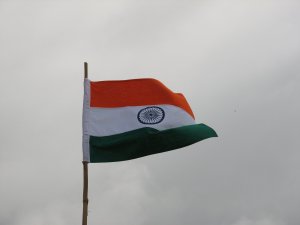
But is it just that? Just respect The Flag according to the Flag code and you are done. Is there nothing beyond this? The point that I want to raise here is that respecting The Nation does not start at respecting The Flag nor does it end there. It goes much more beyond.
The Flag code is just a ritual, but the meaning of it goes much deeper than the rituals associated with it. From what I see The Flag code is just a hollow ritual, which prevents you from seeing things that lie beyond. If you really respect the nation, there are much better ways to do it, rather than giving too much respect to a piece of cloth so revered.
I ask you another question, of all the bureaucrats and the politicians who “officially” enjoy the privilege of The Flag, how many actually deserve it? Even with MPs who have dozens of cases pending against them, can boast having a flag. This I find the worst possible disrespect for The Flag. This offence is much more grave than one in which a person does not follow The Flag Code.
What I mean here is that see beyond The Flag Code, and try to understand what it implies in our actions. If you are following The Flag Code strictly but are corrupt or promote corruption, or do not follow the rules [lets say even trafic rules], not pay the taxes, etc. etc. You are dishonouring The Flag more than you could do by doing away with all the rules in The Flag Code.
Just a passing remark…
The Flag Code [3A vi] in particular mentions a punishable offence:
lettering of any kind shall not be put upon the Flag;
Then what do you say about this: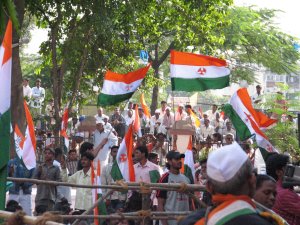
References:
Citation : 2004 SOL Case No. 069
SUPREME COURT OF INDIA
Before :- Brijesh Kumar and S.B. Sinha, JJ.
Civil Appeal No. 2920 of 1996. D/d. 23.1.2004
Union of India – Appellant
Versus
Naveen Jindal and Anr. – Respondents
[Available online here.]
The Flag Code of India
[Available online here.]

Well Mumbai locals are the life line of the city. But ever wondered how many people can one local train carry? Here I try to estimate the carrying capacity of the local train.
We first want to make an order of magnitude guess for the carrying capacity of the
local train. First let us take the dimensions of one coach of the train.
Let us take the width of the coach to be ~ 3 m or 10 ft. We consider the length of the coach to be
of the order of ~50 ft. Then the floor area that we have in each coach is about 500
sq. ft. We neglect the actual seating arrangement in the local, and consider the
floor area only. We make an assumption that all the people are standing in the coach to
get an upper limit on the carrying capacity of the coach. The passengers are standing
as close to each other as possible. Now we make an estimate of how much area one
person requires to stand. One person would require about 1 sq. ft. area to stand.
Thus in a coach of about 500 sq. ft, about 500 people can stand. Actually there are
9 coaches, and their configuration is as follows. In the Central Railways , a 3-coach
unit is classified as 76, 70, or 72, where 76 is the leading motor coach, 70 is the motor
coach with a pantograph, and 72 is the trailer coach. So a nine-coach train has three
units in the following sequence (for the details and lot of other interesting information about Indian Railways visit here):
(76 -70 – 72)(72 – 70 – 76)(72 -70 – 76)
So our guess is near about correct!!
This method of analysis is known as solving problem the Fermi way and the problems are Fermi problems. Named after the 20th century physicist Enrico Fermi, such problems typically involve making justified guesses about quantities that seem impossible to compute given limited available information. Fermi was known for his ability to make good approximate calculations with little or no actual data, hence the name.